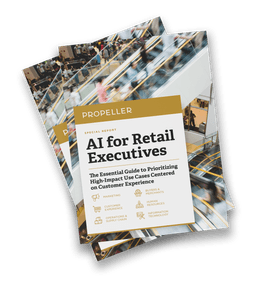AI has quickly become a centerpiece of retail transformation. Across marketing, operations, and customer experience, leaders are exploring how automation, predictive analytics, and intelligent systems can shift how business gets done. But despite the rapid acceleration of investment, few organizations are realizing the full value of their efforts.
Key Takeaways
- Most retailers are experimenting with AI, but few have achieved advanced maturity.
- Organizational readiness — not technology — is the biggest barrier to realizing value.
- Retail leaders need stronger alignment across data, people, and strategy to scale effectively
- The greatest impact comes when AI is applied to enhance customer experience.
- Propeller helps retail leaders assess readiness, prioritize use cases, and build momentum.
Propeller’s latest research shows that while 89% of retail leaders are piloting or scaling AI, only 8% say their organizations have reached an advanced level of maturity. For most, the challenge isn’t identifying use cases but instead building the readiness to deliver and sustain them.

Download the AI Retail Guide
Learn how leading retailers are using AI to enhance CX, streamline operations, and deliver value.
# Why AI Readiness Defines Retail Success
When asked to name their biggest barriers to AI success, retail leaders rarely point to technology. According to the 2025 People & Change Insights Report, the top challenges are organizational: fragmented data, limited internal skills, budget constraints, and resistance to change. Each of these issues limits an organization’s ability to scale pilots into meaningful business impact.
90%
Data Readiness
80%
Talent & Skills Gaps
78%
Resistance to Change
Building readiness often means addressing people, process, and cultural enablers—not just technology. Learn why centering people and processes in your next AI implementation is critical for long-term adoption.
These gaps have a measurable impact. Without accessible, structured data, models underperform. Without leadership alignment, pilots stall. And without a workforce that’s equipped and confident using new tools, adoption lags behind potential.
AI success depends on a strong foundation — one built on clear strategy, cross-functional coordination, and the right level of cultural readiness to support transformation.
That’s where Propeller’s AI in Retail Guide begins. Before it explores where to apply AI, the guide walks leaders through a readiness framework built around six critical dimensions.
# Six Dimensions of AI Readiness in Retail
- Business Strategy and Vision – AI initiatives are directly linked to measurable business goals, with executive ownership and accountability in place.
- Data Availability, Quality, and Integrity – Data is structured, accessible, and governed to support reliable modeling.
- Financial and Resource Readiness – Dedicated funding, skilled talent, and time are allocated to move from pilots to scalable programs.
- People and Organizational Maturity – Teams are engaged, leadership is aligned, and there’s a clear plan for training and adoption.
- Governance and Risk Management – Guardrails are in place for compliance, ethics, and oversight of AI decisions.
- AI Infrastructure and Capabilities – Technology environments are scalable, secure, and interoperable to support enterprise-level AI workloads.
Together, these dimensions give leaders a diagnostic view of where they stand today and where to focus next.
# Stop, Slow, Go: Understanding Organizational Maturity
Organizations can think of readiness in three broad stages:
- Stop: Foundational gaps exist that make AI adoption high-risk. These organizations need to pause and strengthen areas such as data quality, leadership alignment, or governance before moving forward.
- Slow: Early groundwork is in place, but scaling will be difficult until maturity improves in key areas such as funding or workforce capability. Limited, well-defined pilots are possible, but sustained progress will depend on building stronger support systems.
- Go: Most or all dimensions are in place, allowing leaders to advance confidently toward broader AI deployment. The focus shifts from experimentation to prioritization, execution, and continuous improvement.
This diagnostic approach gives executives a way to balance ambition with feasibility, ensuring AI investments start in areas where the organization is truly prepared to deliver.
# Connecting Retail AI Strategy to Customer Experience
Every major retailer is testing AI in some form. Some are optimizing marketing campaigns. Others are applying machine learning to inventory planning or customer service. But across these examples, a consistent pattern emerges: the organizations creating measurable value are the ones that anchor their AI strategy in customer experience.
The guide underscores that distinction. Whether the goal is personalization, faster fulfillment, or more responsive service, the most effective AI initiatives share one outcome: enhancing the experience customers have with the brand.
Retailers like Nike, Sephora, and Walmart are showing what this looks like in practice. AI tools now help Nike’s stores tailor assortments to neighborhood demand, while Sephora uses AI to customize in-app recommendations in real time. Walmart’s “self-healing” inventory system predicts store-level demand and automatically reroutes products to prevent out-of-stocks. Each example reinforces the same principle: AI’s greatest impact comes when it’s applied where business operations meet customer experience.
# High-Impact AI Use Cases for Retail Leaders
What are the most impactful AI use cases in retail right now?
With so much attention on experimentation, many retail organizations are asking a more fundamental question: What’s worth pursuing now?
The AI in Retail Guide outlines six key functional areas where AI is already driving measurable returns:
- Marketing – Personalizing offers, improving conversion, and optimizing spend through predictive modeling.
- Customer Experience – Using chatbots and conversational assistants to deliver always-on support and faster resolution.
- Operations and Supply Chain – Improving forecasting accuracy, inventory efficiency, and real-time decision-making.
- Buying and Merchandising – Using AI-driven assortment planning and dynamic pricing to boost margin and relevance.
- Human Resources – Automating high-volume hiring and mapping internal talent for better workforce agility.
- IT – Strengthening infrastructure reliability through AIOps and accelerating innovation with internal copilots.
Each section in the guide offers two examples: a foundational use case that builds early momentum, and a transformational one suited for organizations ready to scale. This dual approach allows leaders to match ambition with maturity and prioritize the use cases most likely to deliver meaningful results.


# Building Momentum: From AI Readiness to Retail Impact
Even with a solid foundation in place, many retail organizations struggle to move from vision to execution. Leaders know AI can improve performance, but deciding where to focus (and how to build alignment around that choice) can be difficult. Competing priorities, limited resources, and scattered experimentation often slow momentum before meaningful results are achieved.
# How Propeller’s AI Use Case Accelerator Creates Focus
Propeller’s AI Use Case Accelerator is designed to break through that bottleneck. It’s a structured, collaborative process that helps leadership teams identify the AI opportunities with the highest potential value for their business and gain clarity on where to start.
The approach brings order to what can feel like an overwhelming space. Through guided sessions and prioritization criteria, we help organizations:
- Discover where AI can have the most impact by identifying and evaluating opportunities across key functions.
- Deliver alignment by narrowing focus to the use cases that balance business value, feasibility, and risk.
- Activate those priorities through right-sized pilots that generate quick wins while validating long-term value.
- Reinforce progress through ongoing review sessions that keep leadership aligned and AI investments relevant as capabilities evolve.
The outcome is a clear, data-driven roadmap that connects ambition with action. Each client walks away with a focused set of high-value use cases, defined success metrics, and a shared understanding of what comes next.
By bringing structure, prioritization, and consensus to AI decision-making, our approach helps teams move past experimentation and toward measurable business results, ensuring that every initiative contributes to both immediate impact and sustained transformation.
# Next Steps for Retail AI Strategy and Implementation
AI’s potential in retail is enormous, but realizing it takes more than experimentation. The leaders gaining traction today aren’t chasing every possibility; they’re focusing on the few initiatives that create measurable business value and strengthen customer experience.
Propeller’s AI in Retail Guide brings that focus to life. It’s a practical reference for retail executives who want to understand where their organization stands on AI readiness, what it takes to build maturity, and how leading brands are applying AI across marketing, operations, and the customer journey.
Whether you’re evaluating your first pilot or looking to scale existing investments, the guide helps you see where AI can drive the most meaningful impact and how to move forward with confidence.
Download the guide to explore real-world examples, a readiness framework, and Propeller’s perspective on how to turn AI potential into performance.
# Download the AI in Retail Guide
#
Key Questions Retail Leaders Are Asking About AI Readiness and Use Cases
What’s holding most retailers back from realizing AI’s full potential?
Many retailers are stuck between pilot and scale. Data fragmentation, misaligned priorities, and limited internal AI skills make it difficult to turn promising experiments into measurable results. Propeller’s research shows these challenges are more organizational than technical.
How can retail leaders assess their organization’s AI readiness?
AI readiness can be evaluated across six dimensions, from data quality and leadership alignment to governance and infrastructure. Propeller’s AI in Retail Guide provides a practical framework to help leaders benchmark their maturity and identify where to focus first.
Which AI use cases are creating the most value in retail today?
Retailers are realizing measurable results in areas like marketing personalization, predictive demand forecasting, and AI-assisted customer support. The greatest impact comes from initiatives that enhance customer experience and operational efficiency.
What’s the best way to prioritize AI investments across departments?
Propeller’s AI Use Case Accelerator helps leaders identify and rank high-value opportunities by balancing business value, feasibility, and risk. This structured process builds alignment and ensures AI efforts stay focused on measurable impact.
How does Propeller help retail organizations turn AI strategy into results?
Propeller partners with retail leaders to connect AI vision to execution — strengthening readiness, aligning teams, and focusing investments on the use cases that create sustainable business value.




